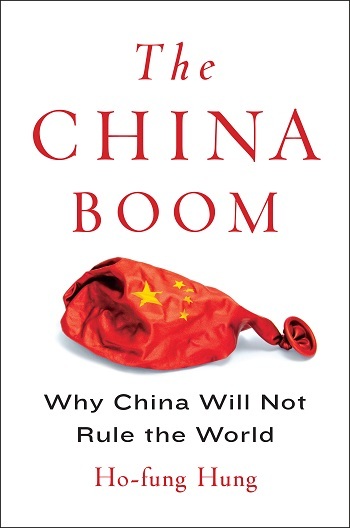Sinomania and Capitalism
“[China’s] economy is also driven by three main engines: domestic consumption, fixed-asset investment, and export. The interconnections among and relative weights of these sectors are mediated by the legacies and paths of China’s long quest for modernity since the Qing dynasty was defeated by European gunboats in the mid–nineteenth century. As such, any account that lacks holistic and historical perspectives is inadequate for a full understanding of capitalist development in China.” — Ho-fung Hung
This week, our featured book is The China Boom: Why China Will Not Rule the World, by Ho-fung Hung. Today, to kick off the feature, we have an excerpt from the introduction, “Sinomania and Capitalism,” in which Hung lays out what he hopes to accomplish in his book and explains what exactly he means by “the China boom.”
Don’t forget to enter our book giveaway for a chance to win a free copy of The China Boom!
After the collapse of Lehman Brothers in September 2008, which unleashed a global financial crisis, China’s export sector crashed at the turn of 2009. In a few months, however, the Chinese economy rebounded strongly into double-digit growth, where it largely had been since the 1980s. At a time when the global economic status quo seemed to be crashing, more than three decades of vibrant economic growth experienced in China—still ruled by the Chinese Communist Party (CCP)—induced excitement and even fantasy about the world’s future among writers on both the left and the right.
To be sure, left-leaning intellectuals and the business elite have different reasons for their euphoria about China, which Perry Anderson calls “Sinomania” (2010). For corporate CEOs, the rise of China and its apparently strong recovery from the crisis represent a vast, new, and limitless frontier for profit, just when business profitability in the advanced capitalist countries is seeing less and less room for expansion. For example, the business-school professor and veteran hedge-fund trader Ann Lee’s best-selling book What the U.S. Can Learn from China: An Open-Minded Guide to Treating Our Greatest Competitor as Our Greatest Teacher (2012) has drawn wide applause from business presses and consultants. The billionaire Donald Trump, who accused China of “stealing” American jobs during his entertaining bid for president in 2012, is in fact an admirer of how business is conducted in China, as he noted at an international hospitability conference in New York in 2008: “In China, they fill up hundreds of acres of land, constantly dumping and dumping
dirt in the ocean. I asked the builder, did you get an environmental impact study? He goes, ‘What?’ I asked, ‘Did you need approval?’ No, the Chinese said. And yet if I am the last guy to drop one pebble in the ocean here in this city [New York], I will be given the electric chair” (qtd. in Heyer 2008).
In the meantime, for some intellectuals, the rise of China represents the emergence of an ultimate challenge to Western domination. Others assert that China’s experience points to a “Chinese model” of capitalist development that is grounded in active state intervention (e.g., Ramo 2004). They see this “model” as a progressive and superior alternative to neoliberal capitalism, which is premised on unregulated free-market forces and has prevailed ever since Ronald Reagan’s and Margaret Thatcher’s free-market reform in the 1980s. State-directed “Chinese capitalism” is hailed for its supposedly better handling of economic crises and its greater effectiveness in sustaining uninterrupted rapid growth and poverty alleviation.
China’s apparent success even leads some to question the viability of the Western democratic system and ponder the virtue of an authoritarian government. For example, the Time magazine article “Why China Does Capitalism Better than the U.S.” suggests that “one of the great ironies revealed by the global recession that began in 2008 is that Communist Party–ruled China may be doing a better job managing capitalism’s crisis than the democratically elected U.S. government” (Karon 2011). Martin Jacques, the former editor of Marxism Today, the organ of the Communist Party of Great Britain, goes so far as to celebrate “the birth of a new global order” and “the end of the Western world,” seeing the 2008 financial crisis as “the beginning of the Chinese world order,” as described in his book When China Rules the World (2009). This book stayed on best-seller lists in the United States and the United Kingdom for many months and was featured favorably in major financial presses. This is not the kind of treatment that a leftish author usually gets.
Just as the eighteenth-century European Sinomania among Enlightenment intellectuals was grounded in partial and sometimes deliberately distorted information about an exotic China (Hung 2003), the latest celebration in the Western world of the Chinese miracle and of its robust recovery from the recent global financial crisis often has been informed by a biased and selective understanding of the underlying dynamics of China’s capitalist boom. China is a large economy, the development of which hinges on complex interaction between private and state-owned sectors. The economy is also driven by three main engines: domestic consumption, fixed-asset investment, and export. The interconnections among and relative weights of these sectors are mediated by the legacies and paths of China’s long quest for modernity since the Qing dynasty was defeated by European gunboats in the mid–nineteenth century. As such, any account that lacks holistic and historical perspectives is inadequate for a full understanding of capitalist development in China.
The first goal of this book is to outline the historical origins of China’s capitalist boom and the social and political formations in the 1980s that gave rise to this boom. It addresses why capitalism did not emerge spontaneously in eighteenth-century China, which was the most prosperous and admired market economy in the early-modern world; how and why state builders in the nineteenth and early twentieth centuries failed to foster state-directed capitalism, as Japan did; and how the rural-agrarian and urban-industrial developments in the Mao period laid the foundation for the capitalist boom in the 1980s. It also discusses the regional, global, and sociopolitical contexts at the turn of the twenty-first century that have made such a boom possible.
As Michel Aglietta (1997, 1998) suggests, capitalism in any particular country is not fundamentally different from capitalism elsewhere (see also Aglietta and Bai 2012; cf. Nee and Opper 2012). The underlying principle and basic dynamics of capitalism as an economic system are universal, though capitalism is always enmeshed in historically and nationally specific sociopolitical structures that enable the release of its productive forces at some times and fetter its reproduction at other times. There is no such thing as “Chinese capitalism” that is fundamentally different from “American capitalism,” “Japanese capitalism,” or “German capitalism.” But this does not mean that the rise of capitalism in China is a simple replication of its rise elsewhere and will produce no distinct effects. On the contrary, capitalism in China is combined with China’s particular social relations, state institutions, and geopolitical interests to present a particular face and to bring particular consequencesto the global order. For example, many China observers have noticed the weight of state-owned enterprises (SOEs), a legacy of the Mao period, in China’s capitalist development and have debated how it has contributed to China’s economic growth and what lesson other developing countries can draw from this contribution (e.g., Y. Huang 2008; Acemoglu and Robinson 2012). Frederic Jameson once remarked metaphorically that “the [capitalist] system is better seen as a kind of virus . . . and its development as something like an epidemic” (1998: 139–40). It follows that even if the capitalist virus is fundamentally the same everywhere, the infected hosts’ responses and behaviors will still diverge depending on the preconditions and characteristics of their bodies. This book is not another attempt to unveil a nonexistent “Chinese capitalism.” Instead,
it is meant to decipher how capitalism adapts to, thrives in, and falters under the Chinese conditions.
This book’s second goal is to explore the global effects of China’s capitalist boom and the limit of that boom. I focus on four common conceptions about how China is reshaping the world and evaluate them against reality. The first conception is that, given the weight of the state-owned sector in the Chinese economy, China is challenging the free-market ideology and global free-market or neoliberal order that the United States has been promoting since the 1980s. The second conception is that China is reversing the long-term trend of income polarization between the industrialized West and the industrializing rest by raising the income level of the vast population of the poor within China. China is also thought to constitute a new model and opportunity for developing countries in their efforts to catch up with developed countries. The third conception is that China is challenging or even replacing the political domination by the West in general and by the United States in particular, thus radically changing the existing world order. The fourth conception is that amid the global crisis that originated in and affected mainly the United States and Europe, China is rescuing the global economy by becoming the most powerful driver of growth.
This book offers a thorough examination of the historical origins, global effects, and imminent demise of China’s recent capitalist boom, constructing a lens through which we can assess the prospect of China’s capitalist development in a more sanguine, comprehensive, and well-informed manner. These four conceptions, which in my view overestimateChina’s transformative impact on the global political economy and the sustainability of the China boom, are critically examined one by one in chapters 3 to 6. In contrast to popular opinion, I show that China is rising as a major, competitive capitalist power implicated in the world market that it is no different from other capitalist powers such as the United States, Japan, and Germany. The China boom has been dependent on the global neoliberal order, which is based on expanding, unfettered transnational flow of goods and capital, and it is in China’s vested
interest to maintain the status quo, though China might seek to change the balance of power within this arrangement. More, China’s own imbalanced developmental path is a key source of rather than the solution to the global economic imbalance that led to the global financial crisis. Just like booms in all other capitalist powers, the China boom, which is the product of a specific concatenation of historical processes and global forces, cannot last forever. Therefore, China is more a foundation of the global status quo and its contradictions than a challenge and solution to it. Its boom is destined to be smashed sooner or later under the weight of imbalances it has created.





